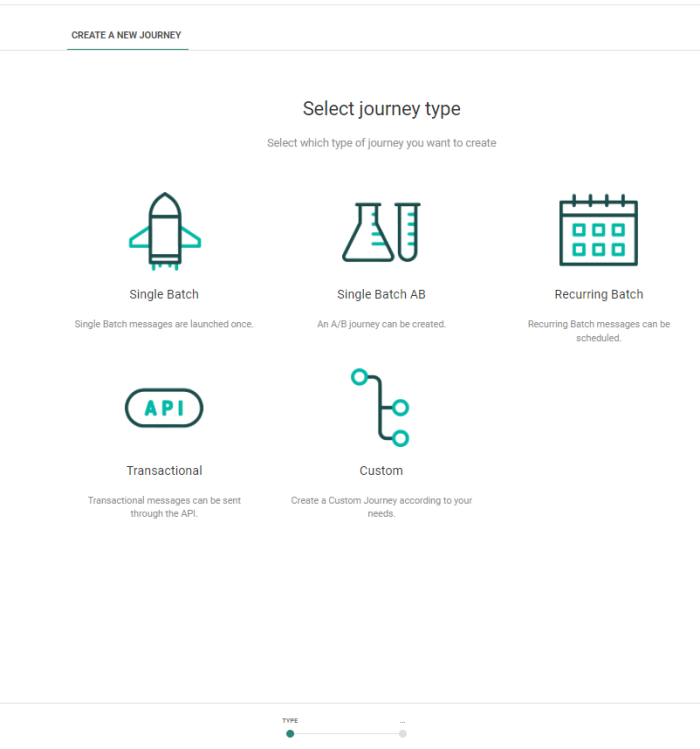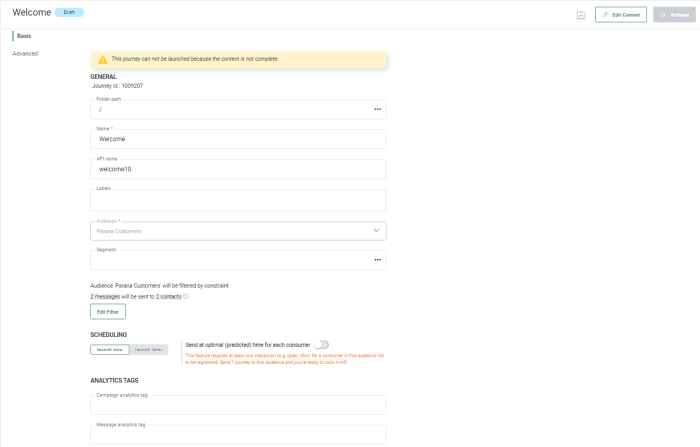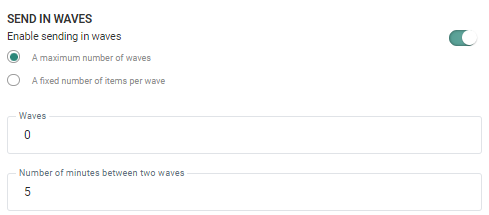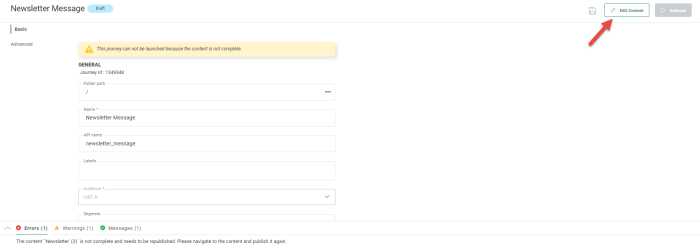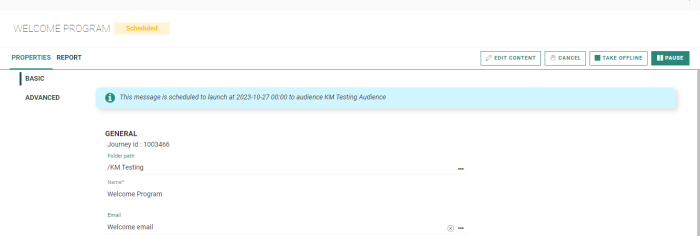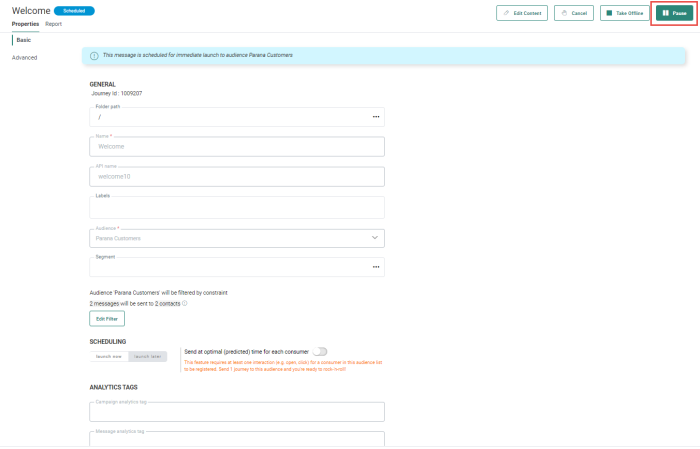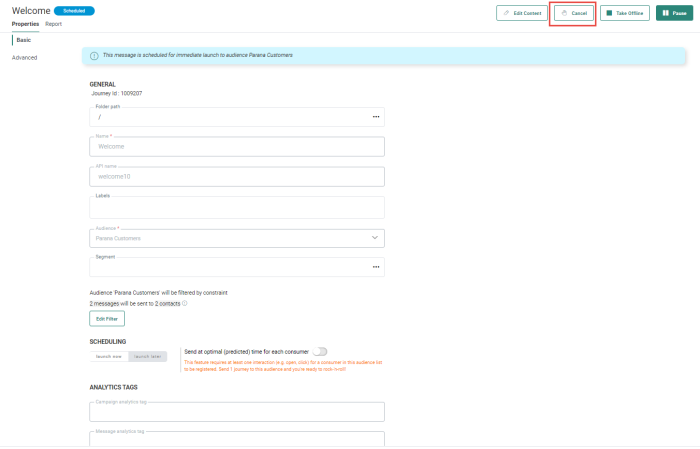Single Batch Journeys use non-transactional messages (email, sms, mobile) and templates and are executed only once, immediately or at a scheduled moment in time. Single Batch Journeys are used for one-time communication such as a promotional email, a newsletter, etc.
In this topic:
Define a Filter on the Audience if Required
Set Analytics Tags When Tracking is Activated (Optional)
Create the Journey
1. To create a Single Batch Journey, start from the Journey fly-out menu, click New and select Single Batch from the wizard.
2. The following screen is displayed. Set the journey properties:
- Folder Path — This is the folder where the asset is created. By default it takes the folder that is currently selected on the Start page when the asset is created. You can modify the path if required. Click the folder field to access the dialog and select a different folder.
- Name — The name by which the journey will be displayed on the Journey Start page and in reporting.
- API-Name — Set the API-Name for the Recurring Batch Journey. This name is used when the journey is executed via the API.
- Asset label — The label(s) assigned to this asset. Select one or more labels from the drop-down. (These labels are configured in the Admin configuration.) Users with the proper Access permissions can also create new labels here by typing the new label value in the field.
- Content — The message, template, SMS or mobile
message to send in this journey. An Asset selector is available to choose the content from. You can choose from all published
messages (indicated with
 ), published
templates (indicated with
), published
templates (indicated with  )
, published mobile push messages (indicated with
)
, published mobile push messages (indicated with  ) or all published SMS and MMS.
When a template or message is selected, a preview is displayed just
below.
) or all published SMS and MMS.
When a template or message is selected, a preview is displayed just
below.
Note: When you choose a content that uses assets in a folder with no access, a warning explains that this content cannot be selected.
Note: Selecting a template or a message results in a different behavior. When template is selected as content source, you will only be able to modify editable sections in the template and add items to a repeater. When message is selected, none of the content is locked and you can modify everything in the message.
When the properties panel is displayed, there are two entries:
- Basic — This is a summary of the properties set during the creation.
- Advanced — This allows you to set additional properties.
Select the Audience
When you create a template or message, the audience is selected to allow you to use fields from the audience as personalization in the content.
When that message is used in a journey, the defined audience is displayed and the number of contacts in the current selected audience is calculated. This audience itself cannot be edited but you can define a filter here.
If segments have been created for the selected audience, you can select one from the folder selector. The count for the number of contacts targeted is adapted automatically.
Note: If the selected list is configured to require segment selection, you MUST select a segment for this list. The journey won't be executed as long as no segment has been selected.
The ![]() icon provides additional details about:
icon provides additional details about:
- The languages available
- The fallback for contacts without a language or with a different language
- Audience limited to contacts with these languages
- Unsubscribes excluded
Define a Filter on the Audience if Required
The Filter icon on the level of the audience count allows the message to be limited to just part of the audience.
Click the Edit Filter button to open the Audience filter dialog in which a constraint can be defined. This constraint can use fields from the following:
- The Audience List
- Any profile extension linked to the Audience List, including 1:1 and 1:n linked lists
- Behavioral data (based on EMIT such as mails sent, delivered, viewed, clicked and last viewed, clicked, delivered)
-
Historical data captured from the contact's channel interaction in a Custom Journey, Recurring Batch, Single Batch and AB Journeys such as general interactions on email (not) viewed, (not) clicked any link, (not) clicked the Unsubscribe link, (not) delivered, etc. you are presented with a list of all journeys and a list of channels for each journey. Any interaction can be used.
- Segments of the selected audience by including or excluding records in the selected segment
For more information on how to build constraints and use them, check out the dedicated topic on that.
When done with the filter, the result after applying the filter to the audience is calculated and the number of contacts is displayed.
Set the Execution Time
You have two options to schedule the message: You can choose to send the message now or at a later time.
- Launch Now: The message is sent immediately when the journey is launched.
- Launch Later: When Later is selected a date and time must be set:
Click the calendar icon to set a date and the clock to set the time of scheduling.
Save these changes.
Note: When you define a scheduled launch time on a journey, the time is expressed in your time zone. The journey will be launched in the time zone of this user at that time.
When a user with a different time zone views the journey, the scheduled time will be translated to their time zone, to reflect the local time.
Internally, the system uses a universal time zone, to make it possible to translate times to localized versions for every user. This means that updates by one user will be correctly represented in the local time zones of all other users.
Example:
User A has a time zone that is set to UTC -5 (Eastern Standard Time).
They schedule a journey to be launched at 6:00 local time (UTC -5).
User B has a user time zone that is set to UTC +1 (Romance Standard Time).
They see a scheduled launch time of 12:00 for that same journey, as their local time has a 6 hour difference compared to user A.
Send-Time Optimization
Send-Time Optimization is used to send messages in journeys at the best time, optimized for the recipient to increase the open rate of a journey. This feature can be activated for each journey individually.
Note: Please reach out to your Marigold contact person to activate this option for your environment.
Toggle the option 'Send at optimal (predicted) time for each consumer' to activate this feature for this journey. The best send-time is calculated for each recipient based on previous interactions for this recipient as well as the audience activity. As a result, the optimal send-time is a weighted combination of the contact and audience STO times. Note that the contact's interaction has a much higher impact on the final STO time.
Technical note: Why is the best send-time using a combination of the best send-time for the contact and for the audience?
There are several situations where this might be needed:
* when there are too little interactions and we cannot be confident about the hours of activity
* when there are a lot of interactions but evenly spread across multiple hours
Note: This option is only available for Single Batch Journeys with an email. It can not be activated for other channels.
As a result, messages are sent out in accordance with the following rules:
- All messages for non-engaged contacts with an unknown best send-time are sent out at the fallback time once the journey is launched and before the end of the day. This fallback time is visible from the journey properties and corresponds to the best send-time for the audience.
- Messages for engaged contacts with a best send-time in the past (before the journey was launched), are sent out immediately.
- All of the others will be sent out at the calculated optimized time, which is a combination of the optimal send-time at consumer level and at audience level, and of course before the end of the day
Note: If the Send-Time optimization option is selected, the Send in wave option is not available. Both options can never be used in combination.
For more details on Send Time Optimization, please check out this topic.
Set Analytics Tags When Tracking is Activated (Optional)
In case trackers are set up for the environment or tracking scripts are used, these can be provided with extra tag values when launching the journey.
In the Journey properties panel, you can enter a value for the Campaign tag and one for the Message tag. These values will be stored and when the message is read and links are clicked, these tag values will be passed on in an URL to the tracker active on the domain. (For more information on trackers, check out this topic). Google Analytics uses these type of tags for instance.
Audience Pre-calculation
- Audience pre-calculation — For some customers, it is beneficial to pre-calculate the audience for an action in a journey well before the actual go-live, or when the load on the environment is lower. The actual journey execution will use the pre-calculated audience when this is available to save time. The option is disabled by default.
- When — Only displayed when the audience pre-calculation is activated. You can choose from the following options:
- Time before execution — The audience is calculated at a specific time interval (expressed in minutes) before the journey is executed. The journey must be scheduled in this case.
- At a fixed time — The audience is calculated at a specific day and time.
- When a task finishes — The audience is calculated when the selected task is finished. You can select a task from a drop-down list of tasks.
- When a task succeeds — The audience is calculated when the selected task succeeds. You can select a task from a drop-down list of tasks.
Sending Out Messages in Waves
The goal of the Wave option is to send out messages, not in one blast but in multiple waves.
You can choose between a specific number of waves to execute or the size of the wave:
Maximum number of waves — Set the max number of waves for this journey. The contacts will be spread over the different waves. If the number of contacts changes, the number of contacts in a wave is recalculated automatically.
A fixed number of items per wave — The number of items is predefined and the number of waves is adapted accordingly. This corresponds to the number of messages that are sent out during one wave.
Number of minutes between two waves — The time between two executions. The time is calculated when the previous wave is executed completely.
Note: When using a Wave option in a journey keep in mind that it can not be used in combination with Send-Time Optimization.
Example : Using Waves in Journeys
Deduplication
If there are duplicate contacts in the journey's audience, you can use Deduplication to select a unique contact based on a field or a combination of fields. This avoids sending the message more than once to the same contact because the contact is in the audience list more than once.
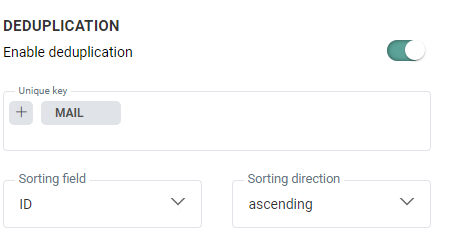
For each journey you can define if deduplication should be activated.
Unique key — You can define the field in the audience that should be used to perform deduplication. This can be a combination of fields as well, for example the Name and email for a contact can be used to detect duplicates.
Note: A maximum of 5 fields can be selected. Fields of type longtext, boolean, float and datetime are not allowed.
Prioritization — Here you define what field in the audience should be used to define the record that has priority over the others in case duplicate records are found. For example, you can use the last update date as a prioritization rule.
Sorting — Choose from ascending or descending to define the record that should be kept.
Sending Limit
The number of records that should be targeted by the journey can be limited to only a sample of the records. Activate the option to target only a selected number of records.
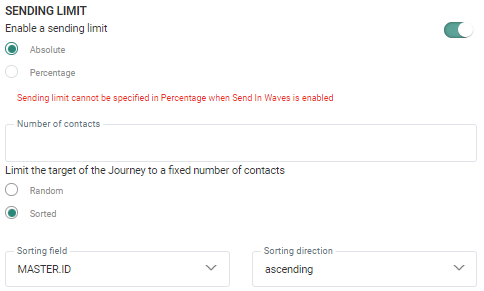
Amount — Defines the number of contacts in the list that should be targeted. You can choose between the following:
- Absolute — Target an absolute number of contacts, ex. a sample of 100.
An additional option is available to indicate what this means when there are multiple executions in a Recurring Batch Journey. - Percentage — Target only a percentage of the contacts, ex. a sample of 10% of the target. Note that you cannot use percentage in combination with the option 'Send in waves'.
Example: For a sending limit of 100, at every execution a sample of 100 records will be targeted.
Selection — Defines if the sample of records need to be selected randomly or if the records first need to be sorted. You can choose between the following:
- Random — Select the records randomly.
- Sort by — Sort the records by a selected field in the list, either ascending or descending.
Example: Select 'Sort by' and 'descending' for the Creation_Date field, to return the most recent records first.
Disable Tracking
In some cases you don't need the journey to be tracked.
For example, a 'Password reset' journey does not require tracking.
Two options are available:
- Interaction tracking
- External analytics tracking
By default, these trackings are enabled. Toggle the option off to disable the tracking.
Interaction tracking
Interaction covers email opens, email clicks, link tracking(emails and pages), and unsubscribe tracking. Disabling this will ensure all these interactions are not logged. This will have an impact on:
- Journey reporting
- Segmentation based on journey metrics
- Send-Time Optimization
But this will not have an impact on:
- Unsubscribe functionality — So when contacts unsubscribe, this will still work
External analytics tracking.
External analytics tracking covers all the external trackers like for example Google UTM, Site tracker, Shop tracker.
When this type of tracking is disabled, no parameters from external trackers will be added to domain related links and hence the information can not be used by the external tracker. This will have an impact on:
- External analytics — E.g. Google analytics
- Site CRM identification — The m_bt parameter will not be added for domain links and hence C RM identification will not be done
- Shop tracker — The parameters that are added for the shop tracker will not be added and hence this will have an impact on revenue reporting
Cadence
Journeys can be added to a cadence plan so that communications over the different channels happen in a controlled way, respecting the rules of the plan. By activating the cadence functionality and selecting a plan from the drop-down, marketers can now add journeys to a cadence plan directly from within the journey. When added to a plan, it will be at the lowest priority. If you want to change this, you need to go to the cadence plan priority tab and change the order of the journey in the list.

Note: You need access right for Cadence to be able to do this and the journey needs to be published.
Editing Content in the Journey
When you create a Single Batch Journey using a message, you have the possibility to make changes to this message, while creating the journey.
1. To do so, use the option Edit content in the Journey toolbar.
Note: When moving away from the journey to the content, you are prompted to either save the changes to the journey, move to the content without saving any changes in the journey or canceling.
2. The Message editor is launched where you can modify the message according to the needs. (For more information on how to add content to a message, check out this section)
3. To return to the journey, click the button Schedule' in the toolbar.
Note: When changes are made and the message is used in other journeys, these changes will also impact those journeys.
Activating the Journey
Once the journey has been configured, save these changes. If you are ready to launch the journey, press the Activate button in the toolbar.
When activating the journey, you are informed about the content that will be sent, the audience and filter applied and the number of contacts that will be targeted. A dialog is displayed with this information. The counts displayed in the dialog take into account the deduplication of records as well as the sending limit defined for the journey.
Note: This dialog is displayed only for users who have the right for audience validation. This is the case by default.
You need to confirm that the audience count is as expected and then launch the journey. If the count is not yet available, you can only cancel the journey launch.
If the journey has been successfully activated, a notification pops up. The info bar in the journey tells you when the journey is scheduled for execution and for which audience.
Note: Once the journey has been launched, the Activate button is no longer available in the toolbar. You can still view the message that has been sent but editing is not possible.
Pausing the Journey
When pausing the journey, links in emails and pages will remain available. Only the sending of messages is paused. While a journey is paused, changes can be made, saved, validated and published. The Journey can then be resumed, and newly processed messages will contain the changed content.
The toolbar contains an additional Pause button that becomes available after the journey was launched.
A paused journey can be activated again or taken offline completely.
Canceling the Journey
It is possible to cancel a journey after it has been launched. As long the journey processing is not finished, you can cancel the journey.
Canceling the journey will stop sending out the new emails but if currently something is still being processed, best effort is made to ensure these will not be delivered to the inbox of the recipients. Also, all links in already sent out emails will continue to work. The status of the journey will be available from the status bar at the top.
Note: When a Journey is canceled you are presented different alerts, depending on the execution status of the journey:
Some messages have been processed : A progress bar gives a very clear and visual representation of what has been processed. You can choose to cancel or keep the journey running.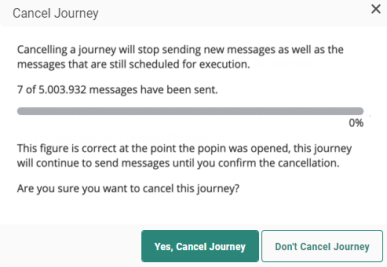
No processing data is available yet: You can choose to cancel the journey anyway or keep the journey running.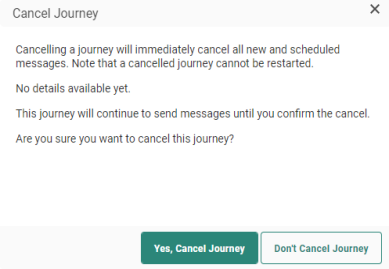
All messages have been processed: In this case, canceling is no longer possible, and the user is informed.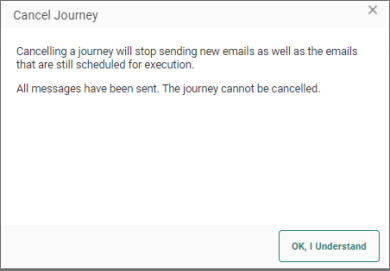
Note: Canceled journeys cannot be relaunched.
Taking the Journey Offline
When taking a journey offline, no messages are sent and links in emails and pages will no longer be available.
The toolbar contains an additional 'Take offline' button that becomes available when the journey has been activated.
An offline journey can be activated again or paused.
Reactivating the Journey
While a journey is pausedor taken offline, it's possible to edit the content through the journey by clicking on the corresponding 'Edit content' button.
If you don't publish the content after you made changes to it, returning to the journey and trying to reactivate it, shows a pop-up explaining that there are unpublished content changes.
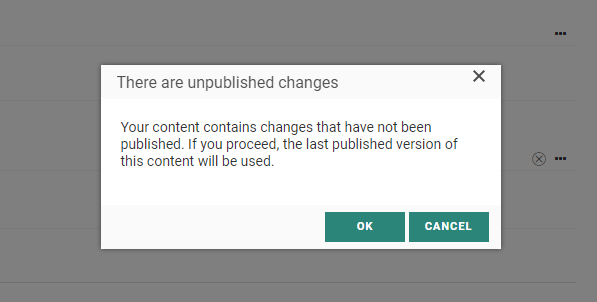
- Click OK to launch the journey anyway using the last published version of the content (without the most recent non-published changes to the content).
- Click CANCEL to go back to the journey wizard and, if needed, publish your last content changes. That way, you can choose to reactivate the journey once more and launch it with the updated published version of the content.
